How to Install the KBRS Tile-Basin®
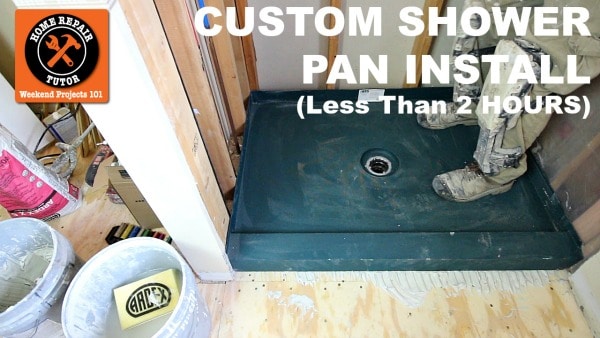
Custom shower pans the best option if you want a 100% waterproof shower.
Recently Steve had to remodel a bathroom that had a leaky fiberglass shower pan.
The prior installer did a poor job and the homeowners stop using the shower after water leaked into the kitchen ceiling.
NOT GOOD!!
Today we’ll show you how to install KBRS’s Tile-Basin® shower pan. Any DIYer can do this project in just a few hours and with minimal tools.
KBRS: What’s the Story?
Many homeowners have shower pan leaks.
Catastrophes happen because either a DIYer or contractor did sloppy work.
We all make mistakes but one small oversight during a shower remodel can lead to expensive repairs.
KBRS approached us to try their shower pans. At first Steve and I weren’t too excited – a lot of companies tout their product as the next godsend.
You can understand our skepticism.
After extensive research we decided the KBRS Tile-Basin® would be a good fit for one of Steve’s clients.
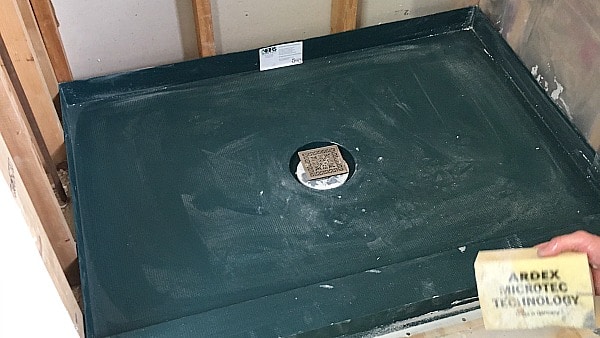
First off, there are no seams in the pan. Plus, KBRS manufactures it to a custom size, shape, and drain location. Then they waterproof everything before shipping the pan.
This means there’s a warranty for the homeowner and the installer. And the pan is 100% waterproof when it gets to the house.
Furthermore, installation time is only a few hours and that saves money for the homeowner!!
What are the first steps for installing the Tile-Basin®?
Step 1: Sound Subfloor
For this project we had 1/2″ plywood over 16″ on-center joists.
We added a 1/4″ layer of plywood to the 1/2″ layer using 16d penny nails and liquid nail in an ‘S’ pattern for extra strength.
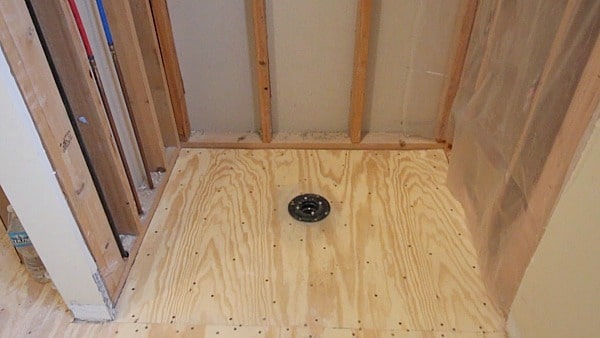
The Tile-Basin® requires 3/4″ wood subfloors, and that’s the reason we added the extra 1/4″ layer.
Since wood subfloors expand and contract, you should never set tile directly on them.
Isolation membranes like DITRA or Flexbone should be used to protect tiles from cracking.

DITRA was used in this bathroom. We followed the Schluter directions for that installation.
Read and watch our DITRA tutorial here.
Step 2: Install the Shower Drain for KBRS Custom Shower Drains
Mud pans are cheap to install.
Yet, getting the 1/4″ per foot slope can be challenging for DIYers.
And this leads to puddling or improper draining of the water – which in turn can result in mold or mildew in the shower.
KBRS’s custom Tile-Basin® shower pans are pre-sloped, which eliminates puddling.
And the Tile-Basin® uses standard shower drains.

Most plumbers will be familiar with these drains, and that’s good if you decide not to install it yourself.
The drain needs to be level with the subfloor for the Tile-Basin® to work properly.

Identify the type of pipes in your home, e.g. this house had ABS pipes.
Then choose a drain that matches the pipe material.
Cut a 4 1/2″ hole for the drain.
And make sure the studs for the screws fit down in the hole.

This helps the drain be flat against the subfloor.
How do you glue the drain to the pipe?
Installers need to determine the height of the pipe coming out of the floor, and glue the drain to that pipe such that the drain sits flush with the subfloor.
Step 3: How to Appropriately Size the Tile-Basin® Shower Pan
We explain in the video how to get the dimensions for the Tile-Basin®.
Set the drain first. This is very important.
Four measurements are required:
- The Depth – 1/2″
- The Width – 1/2″
- Drain Center Measurement from the Back Wall – 1/4″
- Drain Center Measurement from the Mixing Valve Wall – 1/4″
Our shower alcove was 48″ wide by 36″ deep. We subtracted 1/2″ from these dimensions to get 47 1/2″ and 35 1/2″ respectively.
Place the measuring tape on the stud and measure to the center of the drain.

Then subtract 1/4″ from this dimension.
For example, our measurement from the stud to the center of the drain was 15 3/4″. We subtracted 1/4″ to get 15 1/2″.
The center of the drain was 24″ from the mixing valve wall.
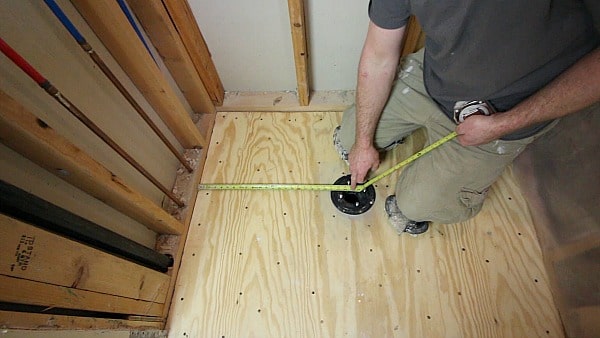
We subtracted 1/4″ from this dimension and got 23 3/4″.
These four measurements are needed by KBRS to make the pan the right size and to place the drain in the correct location.
The 1/4″ off each wall will give you some wiggle room to dry fit the pan.
These are KBRS directions for measuring the Tile-Basin®.
Step 4: Thin-Set KBRS Custom Shower Pans to the Wood Subfloor
Wood subfloors need to be clean before applying thin-set.
Wipe off the subfloor with a damp sponge.

Then burn thin-set into the subfloor with the flat size of a trowel.

KBRS requires a 3/4″ U-Shaped trowel for the Tile-Basin®. Fortunately they give you a plastic version with the pan.
Directionally trowel all the thin-set in the same direction on the subfloor.

Then apply two to three thick beads of KBRS polyurethane sealant on the shower drain.

Finally, embed the Tile-Basin® onto the thin-set and walk on it to compress both the thin-set and the polyurethane.
The last step is to add the clamping ring to the top of the Tile-Basin®.

That’s pretty much all there is to installing Tile-Basin® custom shower pans. It’s very simple and there are no nails required in the outside flange.
The next step is to add 1/4″ furring strips to the studs in the shower. This allows the backer board to hang down into the Tile-Basin® and be sealed to the pan using the KBRS PolySeal® sealant.
We’ll show you how to do that in a future tutorial.
Watch our video to see step-by-step how to install the Tile-Basin® in less than two hours.
[embedded content]
Here’s a picture of the shower after we finished the waterproofing.
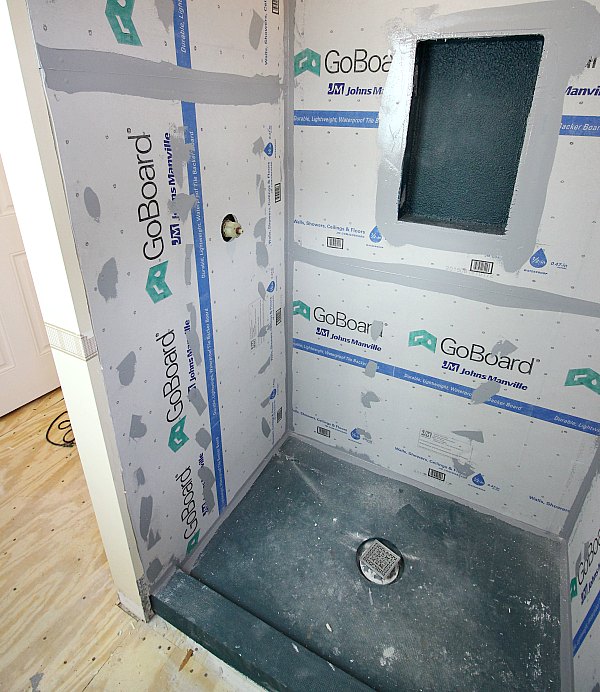
And here’s what the shower looked like after Steve tiled it.
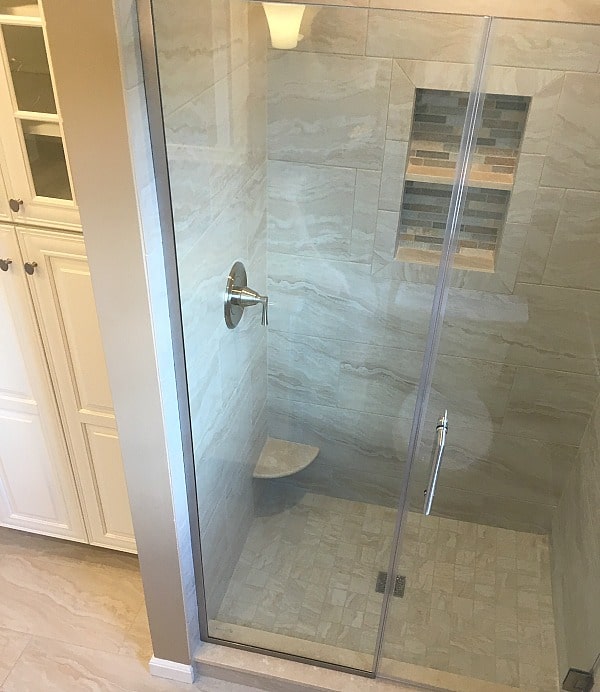
Not too shabby.
What’s Next
If you like the Tile-Basin® and want to shop for one we sell them on Bathroom Repair Tutor.
We’d be happy to answer any questions. Steve and I were very impressed with how quick it was to install. We’re confident that a beginner DIYer or professional could install the Tile-Basin® in just a few hours.
You have to flood test this pan just like any other product for 24 hours. Once that’s done you can immediately start tiling it.
If you’re looking for tutorials showing how to tile a shower we have a few.
Click here to view a tutorial on how to tile a shower wall, specifically the mixing valve wall.
If you’re looking for general tips on how to tile showers click here to see our tutorial called How to Tile a Shower Wall – 9 Quick Tips.
Finally, if you want our latest guide on how to remodel a bathroom you can grab that right here.
Thanks as always for reading, watching, and making HRT a great place for DIYers.
Talk to you soon,

Komentar
Posting Komentar